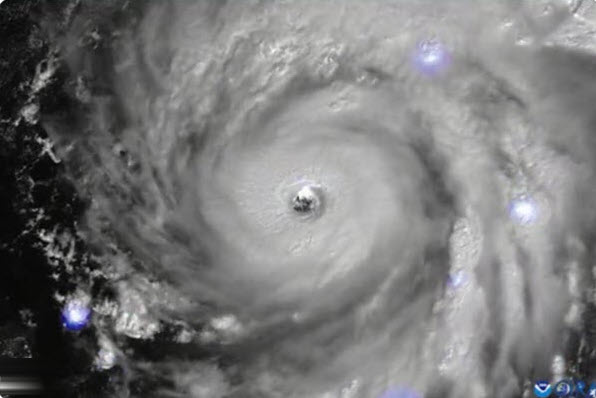
–>
October 8, 2022
As Hurricane Ian hit Florida, Michael Mann of the infamous “hockey stick” global warming graph, and Susan Joy Hassol, publisher of Climate Communication’s “Quick Facts,” which are devoted to explaining extreme weather events as anthropogenic catastrophes, rushed an op-ed piece into print. Their opinion piece, published in The Guardian and predictably entitled, “Hurricane Ian Is No Anomaly,” blamed global warming. Mann and Hassol editorialized:
‘); googletag.cmd.push(function () { googletag.display(‘div-gpt-ad-1609268089992-0’); }); }
Climate change once seemed a distant threat. No more. We now know its face, and all too well. We see it in every hurricane, torrential rainstorm, flood, heatwave, wildfire, and drought. It’s even detectable in our daily weather. Climate disruption has changed the background conditions in which all weather occurs: the oceans and air are warmer, there’s more water vapor in the atmosphere and sea levels are higher. Hurricane Ian is the latest example.
Mann and Hassol argued that “the storms of the past five years—Harvey, Maria, Florence, Michael, Ida, and Ian—aren’t natural disasters as much as human-made disasters whose amplified ferocity is fueled by the continued burning of fossil fuels and the increase in heat-trapping carbon pollution, a planet-warming ‘greenhouse gas.’”
As Green New Deal Neo-Marxist dogma, the Mann-Hassol argument is ideologically compelling. Yet the historical record of hurricanes hitting Florida does not establish that Earth is experiencing a unique “pattern of stronger hurricanes, typhoons, and superstorms” because CO2 emitted by burning hydrocarbon fuels since the Industrial Revolution has caused “the oceans to set record levels of warmth.”
‘); googletag.cmd.push(function () { googletag.display(‘div-gpt-ad-1609270365559-0’); }); }
Michael Shellenberger, author of Apocalypse Never: Why Environmental Alarmism Hurts Us All, has documented that the mainstream media reliably jumped on Hurricane Ian to play their role as the climate hysterics’ echo chamber. The Financial Times, New York Times, Washington Post, and ABC News all ran stories claiming hurricane frequency is on the rise, and that climate change is rapidly fueling super hurricanes.
Shellenberger insists that all such claims are false. “The increasing cost of hurricane damage can be explained entirely by more people and more property in harm’s way,” he wrote in a blog piece entitled, “Media Lying About Climate and Hurricanes,” published on his website. “Consider how much more developed Miami Beach is today compared to a century ago. Once you adjust for rising wealth, there is no trend of increased damage.” Shellenberger also charges that both the Financial Times and the New York Times misrepresented data from the U.S. government’s National Oceanic and Atmospheric Administration (NOAA), purporting to show rising hurricane frequency in landfalls hitting the United States.

Image: Hurricane Ian. Twitter screen grab.
The NOAA webpage that these outlets cite—and that Shellenberger argues they misrepresent—is titled “Global Warming and Hurricanes: An Overview of Current Research Results.” The author is Thom Knutson, a senior scientist at NOAA and at the Geophysical Fluid Dynamics Laboratory (GFDL), last revised the article on October 3, 2022.
In his article, Knutson correctly notes that the United Nations Intergovernmental Panel on Climate Change (IPCC) has repeatedly predicted global warming will cause increased hurricane activity because hurricanes generally form over relatively warm sea surfaces. Thus, he writes, IPCC scientists have used statistical analyses and mathematical models to find a correlation between sea surface temperatures in the Atlantic Ocean (SSTs) and the Power Dissipation Index (PDI). The latter is “an aggregate measure of Atlantic hurricane activity, combining frequency, intensity, and duration of hurricanes.”
NOAA’s data found that “Atlantic SSTs and PDI have risen sharply since the 1970s, and there is some evidence that PDI levels in recent years are higher than in the previous active Atlantic hurricane era in the 1950s and 60s.” But the key to the NOAA analysis is the following:
Climate change detection/attribution studies have linked increasing tropical Atlantic SSTs to increasing greenhouse gases, but such a link between increasing hurricane PDI or frequency to increasing greenhouse gases has not been established.
‘); googletag.cmd.push(function () { googletag.display(‘div-gpt-ad-1609268078422-0’); }); } if (publir_show_ads) { document.write(“
Knutson’s article stresses a significant methodological problem with the time-series analysis of hurricanes. The record of hurricanes before the modern era [i.e., pre-1965] is unreliable because, when it came to ship traffic over the Atlantic, the density of data was “relatively sparse,” with the result that “a substantial number” of hurricanes in the Atlantic were likely not observed.
Adjusting for what is nothing more than an estimated number of unobserved storms, Knutson noted the data shows “a small nominally positive trend (not statistically significant) in tropical storm occurrence from 1878-2006. (Citation omitted.)” In addition, a study establishes that “the rising trend in (unadjusted) Atlantic tropical storm counts is almost entirely due to increases in short-duration (<2 day) storms alone.” Knutson stressed that such short-lived storms “were particularly likely to have been overlooked in the earlier parts of the record, as they would have had less opportunity for chance encounters with ship traffic.”
This close reading of Knutson’s NOAA article makes the dishonesty and hypocrisy that characterizes current mainstream media reporting on climate issues abundantly clear. Knutson’s conclusion, published as a NOAA statement on the matter, reads as follows: “We conclude that the historical Atlantic hurricane data at this stage do not provide compelling evidence for a substantial greenhouse warming-induced century-scale increase in: frequency of tropical storms, hurricanes, or major hurricanes, or in the proportion of hurricanes that become major hurricanes.” (Emphasis in original.)
Australian meteorologist William Kininmonth, a former head of Australia’s National Climate Center, published a recent paper for the Global Warming Policy Foundation in Great Britain entitled “Rethinking the Greenhouse Effect.” Kininmonth correctly notes that with 70 percent of Earth’s surface area made up of oceans, water vapor “is the predominant greenhouse gas in the atmosphere and the primary source of longwave radiation absorbed at the surface.” He further notes that CO2 is a trace molecule in the atmosphere, ranging from 200 parts per million (ppm) typical of the last glacial maximum to 300 ppm in the pre-industrial era, to 400 ppm in current levels, to possibly 600 ppm, a level consistent with future unrestrained industrial emissions.
Kininmonth acknowledges carbon dioxide concentrations do increase the emission of radiation, which in turn increases the temperature of the ocean surface. But he demonstrates that the effect of CO2 over the tropics is small. He writes:
In fact, it is possible to calculate that the increase in carbon dioxide concentrations from 337 ppm to 411 ppm, only results in an increased energy flow of 0.3W/m2 [watts per square meter, a measure of solar irradiance]. This is far too little to explain an increased ocean temperature of 0.4°C [i.e., the amount the ocean surface has warmed over the past 40 years] because the increased temperature in turn increases the flow of energy to the atmosphere by about 3.5W/m2.
He continued:
In other words, while a small amount of extra energy has gone into the tropical ocean surface as a result of increased carbon dioxide, eight times as much has been escaping to the atmosphere. The absorption of additional radiation energy from the change in carbon dioxide concentration is insufficient to support the rise in latent heat loss from the increase in surface temperature.
Kininmonth noted that while the temperature of the tropical oceans has risen over the past four decades, the cause is not CO2. He attributed the likely cause to “a reduction in the transport of heat as the oceans slow.” He stressed that recent tropical ocean warming “is probably simply the result of a fluctuation in the ever-changing ocean circulation; carbon dioxide must be recognized as a very minor contributor to the observed warming and one that is unlikely to prolong the warming trend beyond the peak generated by the natural oceanic oscillations.”
Kininmonth’s final paragraph reads:
The pattern of recent global warming underscores the validity of what meteorologists widely recognize: the oceans are the vital inertial and thermal flywheels of the climate system. The corollary is, if one wants to control climate, it will be necessary to control the oceans. Efforts to decarbonize in the hope of affecting global temperatures will be in vain.
A more definitive rebuke to the deceitful mainstream media reporting on Hurricane Ian is hard to imagine.
<!– if(page_width_onload <= 479) { document.write("
“); googletag.cmd.push(function() { googletag.display(‘div-gpt-ad-1345489840937-4’); }); } –> If you experience technical problems, please write to [email protected]
FOLLOW US ON
<!–
–>
<!– _qoptions={ qacct:”p-9bKF-NgTuSFM6″ }; ![]() –> <!—-> <!– var addthis_share = { email_template: “new_template” } –>
–> <!—-> <!– var addthis_share = { email_template: “new_template” } –>






